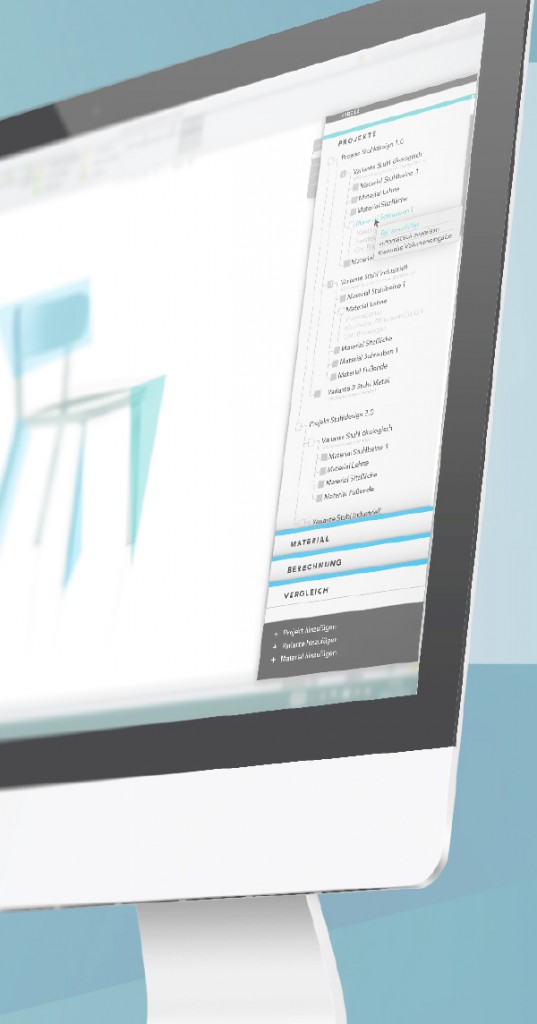
Subject of the project is the development of a navigational and interaction concept as a plug-in called „Circle“ for calculating and evaluating product footprints.
When designing and thinking a product it falls difficult to permanently estimate the resulting pollution, incurred by the choice of the respective materials. How can the designer evaluate the environmental pollution of the product? It would be helpful if an assistant already participates during the design process and advises. It is not just a collection of materials with the listing of their properties, but especially the environmental characteristics of a product as a whole compilation of all his materials and use to calculate and evaluate these, to finally compare each other together.
MIPS
MIPS (MI – Material Input: unit mass in kg, S – service unit: Terms in hours, days and years) is a measure for the natural consumption of a product along the entire
Life cycle from cradle to cradle (production, Production, use, disposal / recycling). Also material consumption during production, use and disposal/recycling is very important for the considerations. The MIPS concept is largely directed to companies. It is tailored practical neither for the „individual“ yet it is easily accessible. While there still isn’t an easy way for Designers to take advantage of the concept, as the MIPS value creation are based on very complex calculations, we think our Plug in could finally help all of them. Right now, it is too complex and difficult for an Engineer or Designer, their focus should be the product, the plug-in supports them in their work.
Our solution: CIRCLE
Circle is a tool that calculates the environmental impact of products and materials depending on their usage context, visualize this results and makes them comparable. The Circle plugin and the webpage constitute a platform, through which the MIPS calculation is practical and understandable. All data points are based on the values (backpack factors) of the Wuppertal Institute, which is the basis for the calculation of the MI and finally the MIPS value.
Gegenstand des Projektes ist die Entwicklung eines Navigations- und Interaktionskonzeptes inform des Plug-ins „Circle“ zum Berechnen und Evaluieren eines Produkt-Footprints. Beim Gestalten und Konzipieren eines Produktes fällt es schwer permanent die entstehende Umweltbelastung, die durch die Wahl der jeweiligen Materialien anfallen, abzuschätzen. Wie kann der Gestalter die Umweltbelastung des Produktes beurteilen? Hilfreich wäre ein Assistent, der bereits während des Designpozesses mitwirkt und berät. Notwendig ist dabei nicht nur eine Sammlung an Materialien mit der Auflistung ihrer Eigenschaften, sondern vor allem die Umwelteigenschaften eines gesamten Produktes in der Zusammenstellung all seiner Materialien & Verwendung zu berechnen und diese zu bewerten sowie miteinander zu vergleichen.
MIPS
MIPS (MI – Materialinput: Masseeinheit in Kg, S – Serviceeinheit: Nutzung in Stunden, Tagen & Jahren) ist ein Maß für den Naturverbrauch eines Produktes entlang des gesamten Lebensweges von der Wiege bis zur Wiege (Gewinnung, Produktion, Nutzung, Entsorgung/Recycling). Dabei spielen auch Materialverbräuche während der Herstellung, der Nutzung sowie der Entsorgung/Recycling eine Rolle. Innovation unserer Anwendung Bislang ist das MIPS-Konzept größtenteils an Unternehmen gerichtet, welche sich z.B. Umwelt- und Ressourcenmanagementsysteme konzipieren lassen und so mittels MIPS lebenszyklusweite Umweltbetrachtungen ihrer Produkte und Dienstleistungen zeitnah vornehmen. Es ist weder für den „Einzelnen“ praktikabel zugeschnitten, noch einfach zugänglich. Für den Gestalter existiert noch keine einfache Möglichkeit das Konzept zu nutzen, da die MIPS-Wert-Erstellung auf sehr aufwendigen Berechnungen beruht. Folglich ist es zu komplex und nur schwer für einen Ingenieur oder Designer anwendbar.
Unsere Lösung: CIRCLE
Circle ist ein Tool, welches die Umweltbelastung von Produkten & Materialien in Abhängigkeit ihres Nutzungszusammenhangs berechnet, visualisiert und vergleichbar macht. Das Circle-Plugin und die gleichnamige Website bilden eine Plattform, durch welche die MIPS-Berechnung praktikabel und verständlich wird. Grundlage sind die bereits existierenden Werte (Rucksackfaktoren) des Wuppertalinstituts, welche die Berechnungsbasis für den MI- und schließlich den MIPSWert eines Produktes bilden.
In Zusammenarbeit mit : Karolin Krumpolt, Marlen Häselbarth, Rene Schwenk